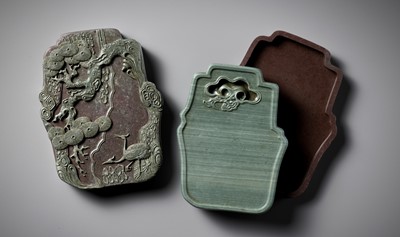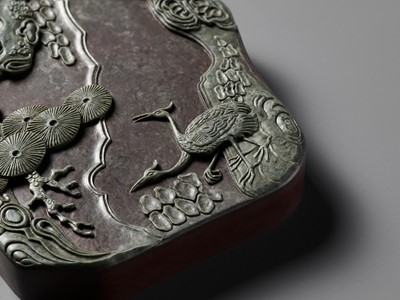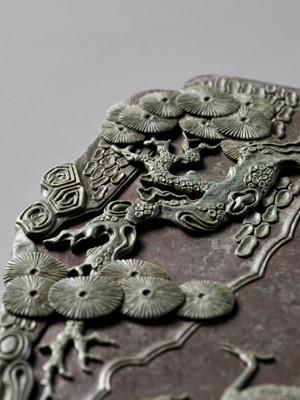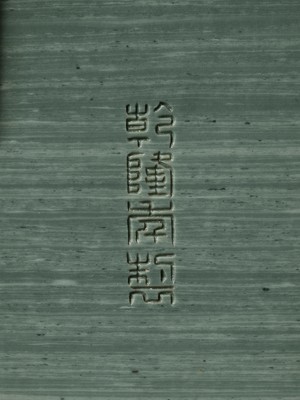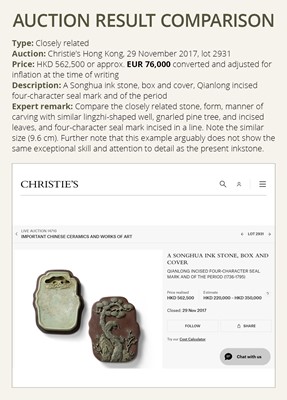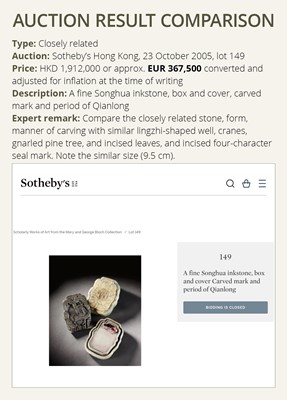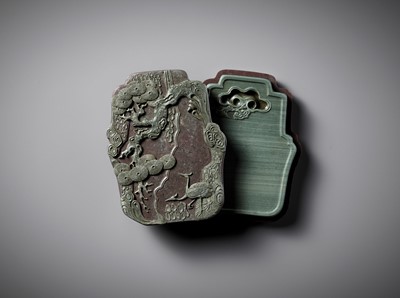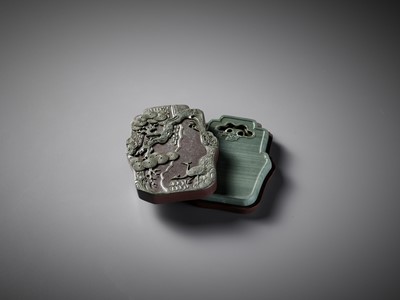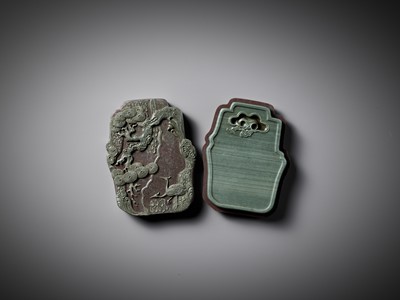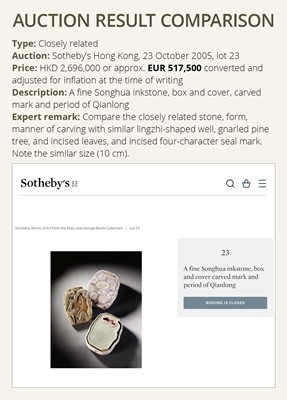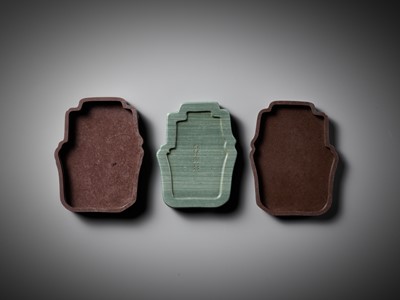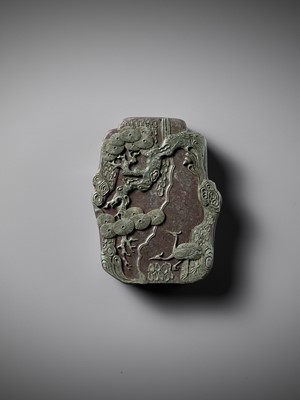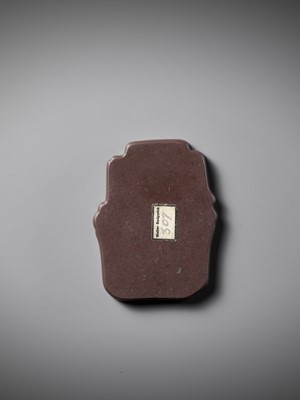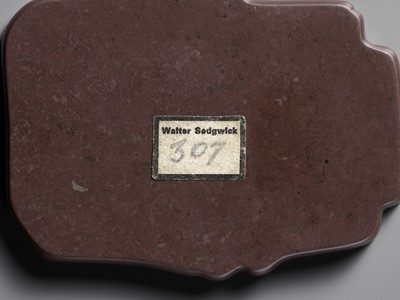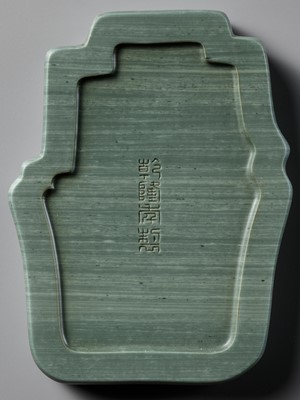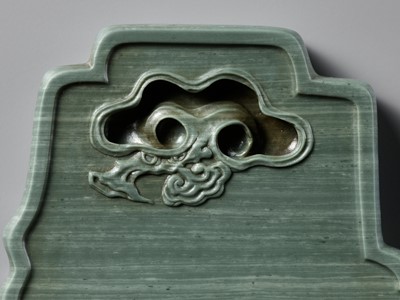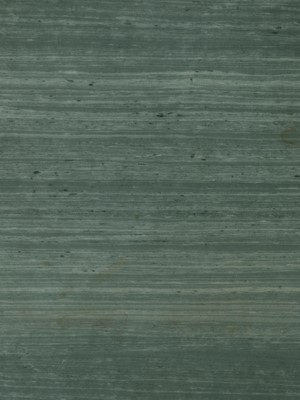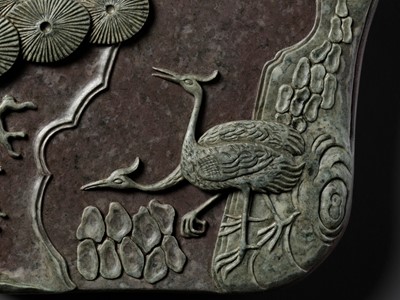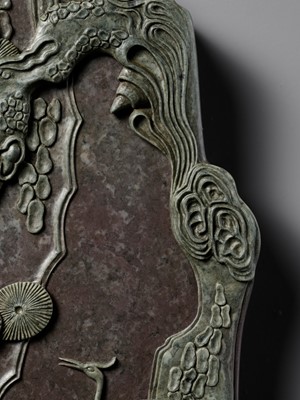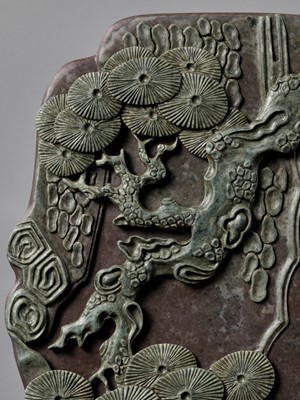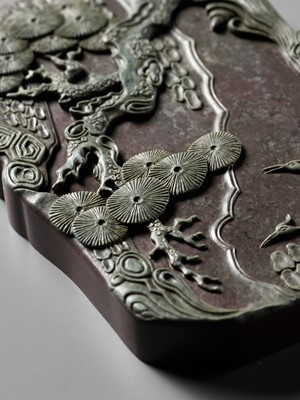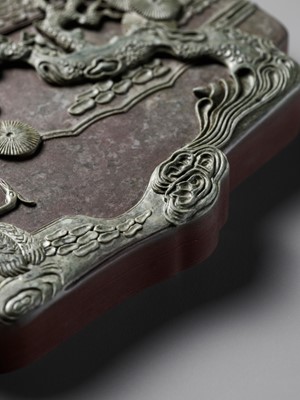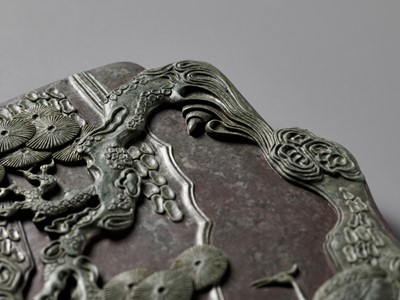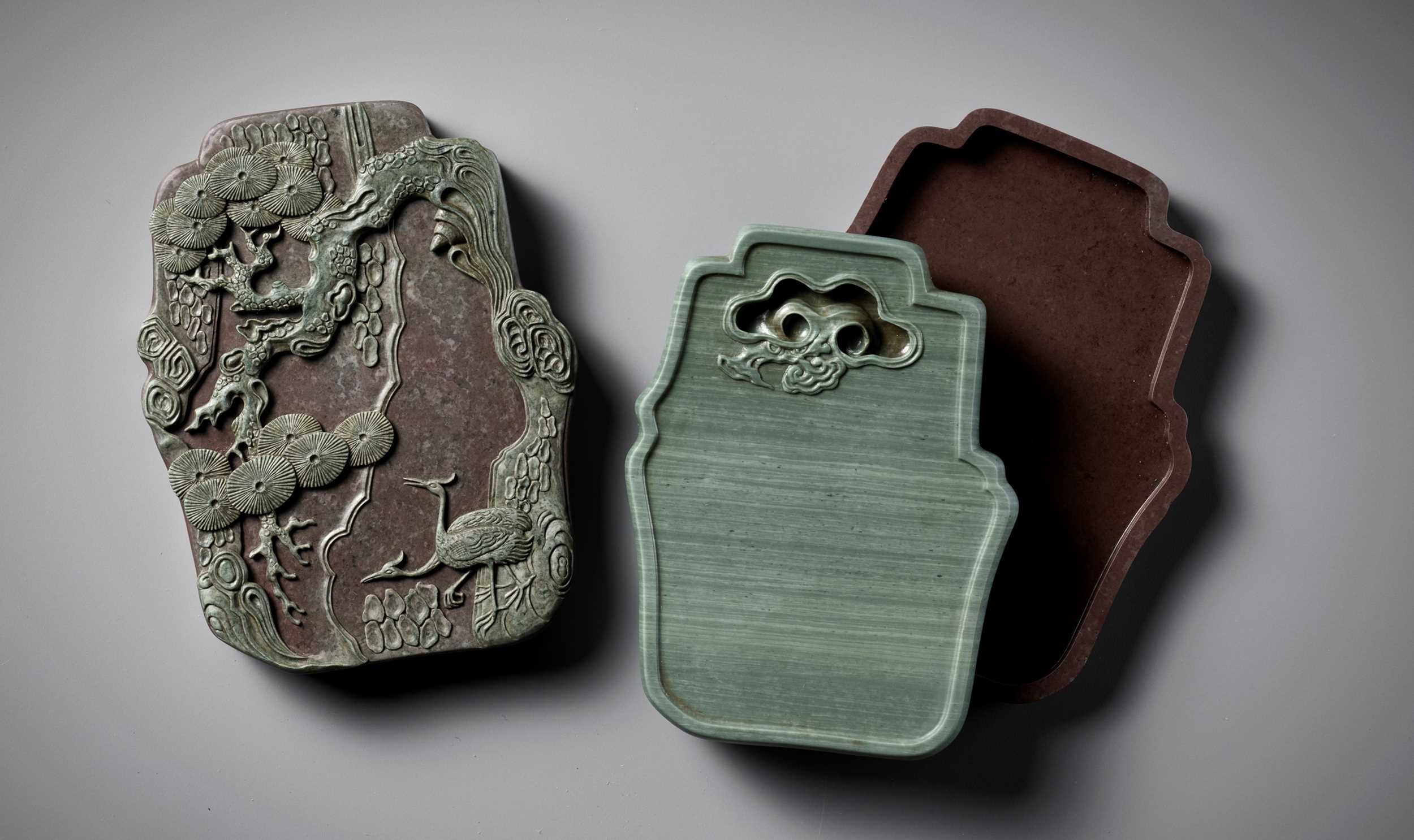29th Sep, 2022 13:00
DAY 1 - TWO-DAY AUCTION - Fine Chinese Art / 中國藝術集珍 / Buddhism & Hinduism
26
A SONGHUA INK STONE, BOX AND COVER, QIANLONG MARK AND PERIOD
乾隆款及年代松花硯
Sold for €20,800
including Buyer's Premium
China, 1736-1795. The soft grayish-green ink stone is of magnificent quality with distinct striations and deeply carved with a lingzhi-shaped well. The outline conforms with the highest possible precision to that of the shallow box and cover, which in turn is finely carved on the top through the grayish-green outer layer to the purplish-brown under layer with two crested cranes perched on the trunk of a gnarled pine tree, the burls in the wood superbly sculpted, the pine leaves and the cranes’ plumages neatly incised.
The base of the inkstone incised in a line with a four-character seal mark Qianlong nianzhi and of the period.
Provenance: Mrs. Walter Sedgwick, collection no. 307, as per old label to base, and thence by descent. Probably Sotheby’s London after 1968 and from there into a French collection. Parisian trade, acquired from the above. Mrs. Walter Sedgwick (1883-1967) was an English collector of Chinese art who came from a family of architects. Quite unusually at the time, she collected independently of her husband who was a barrister with little interest in Chinese art. She lent many pieces to the 1935-36 Chinese exhibition at the Royal Academy. Soame Jenyns described her as a collector of impeccable taste and in 1953 dedicated his book 'Ming Pottery and Porcelain' to her. She donated and bequeathed Chinese objects to the British Museum from 1933 to 1968 and was a generous benefactor to the British Museum, the Fitzwilliam in Cambridge, and the Victoria & Albert Museum. After her death, her collection was sold off by Sotheby’s London beginning in 1968. Mrs. Sedgwick was the aunt of Professor Jessica Rawson.
Condition: Excellent condition with only minor wear and traces of use.
Weight: 243.6 g
Dimensions: Length 9 cm
Expert’s note: The present lot was no doubt made during the Qianlong period, a fact illuminated by a Songhua ink stone, box, and cover dated to the Republic period at Christie’s Hong Kong, 9 October 2019, lot 270. Although this later example appears quite similar to the present lot at first glance, it quickly becomes evident that it does not even remotely show the same exceptional skill and attention to detail. Closer study reveals a vast number of small yet striking differences, including the two cranes, which lack the crests and open beaks, as well as the pine leaves, which lack the raised edges of their central circles, and last but not least the Imperial mark itself, which is by far not as neatly incised.
Songhua stone, for its color, quality and ease of grinding the ink, was one of the preferred materials for making inkstones for the scholar's table during the Qing dynasty. Chi Jo-hsin in 'A study of the Sunghua Inkstone Tradition', Special Exhibition of Sunghua Inkstone, National Palace Museum, Taipei, 1993, page 38, notes that 'during the Qianlong period, an inventory of inkstones in the Imperial Household was compiled. Of the more than two hundred entries, six sunghua inkstones with imperial reign marks of the K'ang-hsi, Yung-cheng and Ch'ien-lung periods are recorded, five of which are in the collection of the National Palace Museum.'
Design on inkstones often imitated fine paintings and it is known that the Qianlong emperor commissioned his court painters to design the lids of many of his inkstones. Shapes of the ink pool and cover also became more varied during the Qianlong emperor's reign, when new shapes in the form of peaches, crescent-moons and flowers were introduced alongside the traditional circular, octagonal and oblong shapes.
In Qianlong’s poetry collection ‘Shengjing tuchan zoayang shier shou’ (Twelve Miscellaneous Poems on the Native Products of Shengjing), the emperor praises the stone as 'Songhua yu' (Songhua jade) and mentions that it is the product of the Yuantong River in Jilin province in northeast China and can be used for making inkstones.
Zhou Nanquan notes in 'Songhuashi yan' (Songhua Inkstone), Wenwu, 1980, no. 1, pages 86-87, that Songhua stone was used for the production of imperial inkstones from the early to mid-Qing dynasty. Zhou further notes that in the 39th year of Qianlong's reign (corresponding to 1774), official records mention a total of 120 Songhua stone pieces, whether worked or as raw material, in the Palace collection.
Records from the fourth day of the twelfth month of the 39th year of Qianlong's reign note that on three occasions, raw material amounting to 38 pieces from Jilin province, was sent to the palace and, out of five stone pieces, eight inkstones and their boxes were made. It was customary with Songhua stone from the palace to have the inkstones in original boxes of the same material, usually using the different stratified colors. Currently there are eighty Songhua inkstones in the Palace Museum collection, of which ten are attributed to Kangxi, sixteen to Yongzheng, thirteen to Qianlong, nine to Jiaqing, one to Daoguang and five to Guangxu's reigns.
Literature comparison:
A related ink stone, box, and cover was included in Selected Treasures of Chinese Art, Hong Kong, 1990, cat. no. 238. A related Qianlong inkstone and cover of rectangular shape, also carved with pine trees and cranes, was included in the Special Exhibition of Songhua Inkstone, National Palace Museum, Taipei, 1993, cat. no. 57.
Auction result comparison:
Type: Closely related
Auction: Christie’s Hong Kong, 29 November 2017, lot 2931
Price: HKD 562,500 or approx. EUR 76,000 converted and adjusted for inflation at the time of writing
Description: A Songhua ink stone, box and cover, Qianlong incised four-character seal mark and of the period
Expert remark: Compare the closely related stone, form, manner of carving with similar lingzhi-shaped well, gnarled pine tree, and incised leaves, and four-character seal mark incised in a line. Note the similar size (9.6 cm). Further note that this example arguably does not show the same exceptional skill and attention to detail as the present inkstone.
Auction result comparison:
Type: Closely related
Auction: Sotheby’s Hong Kong, 23 October 2005, lot 23
Price: HKD 2,696,000 or approx. EUR 517,500 converted and adjusted for inflation at the time of writing
Description: A fine Songhua inkstone, box and cover, carved mark and period of Qianlong
Expert remark: Compare the closely related stone, form, manner of carving with similar lingzhi-shaped well, gnarled pine tree, and incised leaves, and incised four-character seal mark. Note the similar size (10 cm).
Auction result comparison:
Type: Closely related
Auction: Sotheby’s Hong Kong, 23 October 2005, lot 149
Price: HKD 1,912,000 or approx. EUR 367,500 converted and adjusted for inflation at the time of writing
Description: A fine Songhua inkstone, box and cover, carved mark and period of Qianlong
Expert remark: Compare the closely related stone, form, manner of carving with similar lingzhi-shaped well, cranes, gnarled pine tree, and incised leaves, and incised four-character seal mark. Note the similar size (9.5 cm).
乾隆款及年代松花硯
中國,1736-1795年。温潤如玉,紂綠無瑕,深刻靈芝形井。淺盒和蓋子的輪廓一致,硯蓋上精美雕刻了松鶴紋理,松樹的瘤節與松針和鶴的羽毛細節分明,雕刻精美。石質、石色、石形和藝術設計和雕制巧妙地結合起來。
底部四字篆書款“乾隆年製”。
來源:Walter Sedgwick夫人收藏,底部可見收藏編號 307,保存至今;可能1968年后由倫敦蘇富比進入法國收藏; 法國古玩交易,購於拍賣。Walter Sedgwick (1883-1967) 夫人是一位來自英國建築師世家的中國藝術品收藏家。在當時頗為不同尋常的是,她獨自收藏,丈夫是一名對中國藝術毫無興趣的大律師。1935-36 年她將許多作品借給皇家藝術學院的中國展覽。Soame Jenyns 將她描述為品味無可挑剔的收藏家,並於 1953 年將他的著作Ming Pottery and Porcelain獻給她。1933年至1968年,她向大英博物館捐贈了很多中國藏品,她是大英博物館、劍橋菲茨威廉博物館和維多利亞與阿爾伯特博物館的慷慨捐助者。 在她去世後,她的收藏於 1968 年開始被倫敦蘇富比拍賣。Sedgwick夫人是Jessica Rawson教授的姑姑。
品相:狀況極佳,只有輕微磨損和使用痕跡。
重量:243.6 克
尺寸:長 9 厘米
專家注釋:此拍品無疑為乾隆年間所製,與一件在香港佳士得2019年 10 月 9 日,拍品編號 270的民國時期松花硯、盒及蓋相比,許多微小但顯著的差異,包括鶴,以及對松針的表現,除此之外最後但並非最不重要的一點是帝國標記本身,到目前為止還沒有被切割得很整齊。
松花石以其色、質、易磨墨等特點,成為清代文人桌硯的首選用品之一。1993年,台北故宮博物院《松花硯特展》《宋化硯傳統研究》第38頁,嵇若昕指出,“乾隆年間,曾編撰皇室硯台目錄,兩百餘件中,記載了康熙、雍正、乾隆三代松花硯六件,其中五件為故宮博物院收藏。”
硯台上的設計經常模仿繪畫題材,眾所周知,乾隆皇帝委託他的宮廷畫家設計了許多硯台的蓋子。乾隆年間,墨池和蓋的形狀也變得更加多樣化,除了傳統的圓形、八角形和長方形之外,還引入了桃形、月牙形和花朵形等新形狀。清乾隆時《盛京土產雜詠十二首》序中說“混同江產松花玉,可以為硯材”。松花硯是由產自吉林長白山地區的松花石雕制而成。
用松花石制硯始於明代末年,推崇於清朝。周南泉在《松花石硯》(《文物》1980年,第1期,頁86-87)指出,松花石用於製作清朝早期至中期的皇家硯台,在乾隆三十九年(對應於1774年),官方記錄提到在宮殿收藏中總共有120件松花石,無論是加工的還是作為原材料的。
乾隆三十九年十二月初四的記載,曾三度將吉林省的三十八件原料送入宮中,製作了五件石硯以及八件盒子。宮中的松花石習慣上將硯放在同材質的原盒中,通常使用不同的分層顏色。目前故宮博物院收藏松花石八十件,其中康熙十件,雍正十六件,乾隆十三件,嘉慶九件,道光一件,光緒五件。
文獻比較:
一件相近的硯和蓋盒,見《中華文物》,香港,1990年,圖錄編號238。一件相近的乾隆硯和蓋盒,也飾有松樹和仙鶴,曾展覽於 《品埒端歙:松花石硯特展》,台北故宮博物館,1993年,圖錄編號57。
拍賣結果比較:
形制:非常相近
拍賣:香港佳士得,2017年11月29日,lot 2931
價格:HKD 562,500(相當於今日EUR 76,000)
描述:清乾隆松花石硯連隨形硯盒,「乾隆年製」刻款
專家評論:比較非常相近的石質、外型、相似的靈芝狀雕刻、松樹和陰刻樹葉,以及直刻的乾隆四字款識。請注意相似的尺寸(9.6厘米)。請進一步注意,此硯可以說沒有表現出與現拍品一樣的特殊技巧和對細節的關注。
拍賣結果比較:
形制:非常相近
拍賣:香港蘇富比,2005年10月23日,lot 23
價格:HKD 2,696,000(相當於今日EUR 517,500)
描述:乾隆款及年代松花硯及蓋盒
專家評論:比較非常相近的石質、外型、相似的靈芝狀雕刻、松樹和陰刻樹葉,以及乾隆四字款識。請注意相似的尺寸(10厘米)。
拍賣結果比較:
形制:非常相近
拍賣:香港蘇富比,23 10月 2005年,lot 149
價格:HKD 1,912,000 EUR 367,500(相當於今日)
描述:乾隆款及年代松花硯及蓋盒
專家評論:比較非常相近石質、外型、相似的靈芝狀雕刻、仙鶴、松樹和陰刻樹葉,以及乾隆四字款識。請注意相似的尺寸(9.5厘米)。
#videohighlight
China, 1736-1795. The soft grayish-green ink stone is of magnificent quality with distinct striations and deeply carved with a lingzhi-shaped well. The outline conforms with the highest possible precision to that of the shallow box and cover, which in turn is finely carved on the top through the grayish-green outer layer to the purplish-brown under layer with two crested cranes perched on the trunk of a gnarled pine tree, the burls in the wood superbly sculpted, the pine leaves and the cranes’ plumages neatly incised.
The base of the inkstone incised in a line with a four-character seal mark Qianlong nianzhi and of the period.
Provenance: Mrs. Walter Sedgwick, collection no. 307, as per old label to base, and thence by descent. Probably Sotheby’s London after 1968 and from there into a French collection. Parisian trade, acquired from the above. Mrs. Walter Sedgwick (1883-1967) was an English collector of Chinese art who came from a family of architects. Quite unusually at the time, she collected independently of her husband who was a barrister with little interest in Chinese art. She lent many pieces to the 1935-36 Chinese exhibition at the Royal Academy. Soame Jenyns described her as a collector of impeccable taste and in 1953 dedicated his book 'Ming Pottery and Porcelain' to her. She donated and bequeathed Chinese objects to the British Museum from 1933 to 1968 and was a generous benefactor to the British Museum, the Fitzwilliam in Cambridge, and the Victoria & Albert Museum. After her death, her collection was sold off by Sotheby’s London beginning in 1968. Mrs. Sedgwick was the aunt of Professor Jessica Rawson.
Condition: Excellent condition with only minor wear and traces of use.
Weight: 243.6 g
Dimensions: Length 9 cm
Expert’s note: The present lot was no doubt made during the Qianlong period, a fact illuminated by a Songhua ink stone, box, and cover dated to the Republic period at Christie’s Hong Kong, 9 October 2019, lot 270. Although this later example appears quite similar to the present lot at first glance, it quickly becomes evident that it does not even remotely show the same exceptional skill and attention to detail. Closer study reveals a vast number of small yet striking differences, including the two cranes, which lack the crests and open beaks, as well as the pine leaves, which lack the raised edges of their central circles, and last but not least the Imperial mark itself, which is by far not as neatly incised.
Songhua stone, for its color, quality and ease of grinding the ink, was one of the preferred materials for making inkstones for the scholar's table during the Qing dynasty. Chi Jo-hsin in 'A study of the Sunghua Inkstone Tradition', Special Exhibition of Sunghua Inkstone, National Palace Museum, Taipei, 1993, page 38, notes that 'during the Qianlong period, an inventory of inkstones in the Imperial Household was compiled. Of the more than two hundred entries, six sunghua inkstones with imperial reign marks of the K'ang-hsi, Yung-cheng and Ch'ien-lung periods are recorded, five of which are in the collection of the National Palace Museum.'
Design on inkstones often imitated fine paintings and it is known that the Qianlong emperor commissioned his court painters to design the lids of many of his inkstones. Shapes of the ink pool and cover also became more varied during the Qianlong emperor's reign, when new shapes in the form of peaches, crescent-moons and flowers were introduced alongside the traditional circular, octagonal and oblong shapes.
In Qianlong’s poetry collection ‘Shengjing tuchan zoayang shier shou’ (Twelve Miscellaneous Poems on the Native Products of Shengjing), the emperor praises the stone as 'Songhua yu' (Songhua jade) and mentions that it is the product of the Yuantong River in Jilin province in northeast China and can be used for making inkstones.
Zhou Nanquan notes in 'Songhuashi yan' (Songhua Inkstone), Wenwu, 1980, no. 1, pages 86-87, that Songhua stone was used for the production of imperial inkstones from the early to mid-Qing dynasty. Zhou further notes that in the 39th year of Qianlong's reign (corresponding to 1774), official records mention a total of 120 Songhua stone pieces, whether worked or as raw material, in the Palace collection.
Records from the fourth day of the twelfth month of the 39th year of Qianlong's reign note that on three occasions, raw material amounting to 38 pieces from Jilin province, was sent to the palace and, out of five stone pieces, eight inkstones and their boxes were made. It was customary with Songhua stone from the palace to have the inkstones in original boxes of the same material, usually using the different stratified colors. Currently there are eighty Songhua inkstones in the Palace Museum collection, of which ten are attributed to Kangxi, sixteen to Yongzheng, thirteen to Qianlong, nine to Jiaqing, one to Daoguang and five to Guangxu's reigns.
Literature comparison:
A related ink stone, box, and cover was included in Selected Treasures of Chinese Art, Hong Kong, 1990, cat. no. 238. A related Qianlong inkstone and cover of rectangular shape, also carved with pine trees and cranes, was included in the Special Exhibition of Songhua Inkstone, National Palace Museum, Taipei, 1993, cat. no. 57.
Auction result comparison:
Type: Closely related
Auction: Christie’s Hong Kong, 29 November 2017, lot 2931
Price: HKD 562,500 or approx. EUR 76,000 converted and adjusted for inflation at the time of writing
Description: A Songhua ink stone, box and cover, Qianlong incised four-character seal mark and of the period
Expert remark: Compare the closely related stone, form, manner of carving with similar lingzhi-shaped well, gnarled pine tree, and incised leaves, and four-character seal mark incised in a line. Note the similar size (9.6 cm). Further note that this example arguably does not show the same exceptional skill and attention to detail as the present inkstone.
Auction result comparison:
Type: Closely related
Auction: Sotheby’s Hong Kong, 23 October 2005, lot 23
Price: HKD 2,696,000 or approx. EUR 517,500 converted and adjusted for inflation at the time of writing
Description: A fine Songhua inkstone, box and cover, carved mark and period of Qianlong
Expert remark: Compare the closely related stone, form, manner of carving with similar lingzhi-shaped well, gnarled pine tree, and incised leaves, and incised four-character seal mark. Note the similar size (10 cm).
Auction result comparison:
Type: Closely related
Auction: Sotheby’s Hong Kong, 23 October 2005, lot 149
Price: HKD 1,912,000 or approx. EUR 367,500 converted and adjusted for inflation at the time of writing
Description: A fine Songhua inkstone, box and cover, carved mark and period of Qianlong
Expert remark: Compare the closely related stone, form, manner of carving with similar lingzhi-shaped well, cranes, gnarled pine tree, and incised leaves, and incised four-character seal mark. Note the similar size (9.5 cm).
乾隆款及年代松花硯
中國,1736-1795年。温潤如玉,紂綠無瑕,深刻靈芝形井。淺盒和蓋子的輪廓一致,硯蓋上精美雕刻了松鶴紋理,松樹的瘤節與松針和鶴的羽毛細節分明,雕刻精美。石質、石色、石形和藝術設計和雕制巧妙地結合起來。
底部四字篆書款“乾隆年製”。
來源:Walter Sedgwick夫人收藏,底部可見收藏編號 307,保存至今;可能1968年后由倫敦蘇富比進入法國收藏; 法國古玩交易,購於拍賣。Walter Sedgwick (1883-1967) 夫人是一位來自英國建築師世家的中國藝術品收藏家。在當時頗為不同尋常的是,她獨自收藏,丈夫是一名對中國藝術毫無興趣的大律師。1935-36 年她將許多作品借給皇家藝術學院的中國展覽。Soame Jenyns 將她描述為品味無可挑剔的收藏家,並於 1953 年將他的著作Ming Pottery and Porcelain獻給她。1933年至1968年,她向大英博物館捐贈了很多中國藏品,她是大英博物館、劍橋菲茨威廉博物館和維多利亞與阿爾伯特博物館的慷慨捐助者。 在她去世後,她的收藏於 1968 年開始被倫敦蘇富比拍賣。Sedgwick夫人是Jessica Rawson教授的姑姑。
品相:狀況極佳,只有輕微磨損和使用痕跡。
重量:243.6 克
尺寸:長 9 厘米
專家注釋:此拍品無疑為乾隆年間所製,與一件在香港佳士得2019年 10 月 9 日,拍品編號 270的民國時期松花硯、盒及蓋相比,許多微小但顯著的差異,包括鶴,以及對松針的表現,除此之外最後但並非最不重要的一點是帝國標記本身,到目前為止還沒有被切割得很整齊。
松花石以其色、質、易磨墨等特點,成為清代文人桌硯的首選用品之一。1993年,台北故宮博物院《松花硯特展》《宋化硯傳統研究》第38頁,嵇若昕指出,“乾隆年間,曾編撰皇室硯台目錄,兩百餘件中,記載了康熙、雍正、乾隆三代松花硯六件,其中五件為故宮博物院收藏。”
硯台上的設計經常模仿繪畫題材,眾所周知,乾隆皇帝委託他的宮廷畫家設計了許多硯台的蓋子。乾隆年間,墨池和蓋的形狀也變得更加多樣化,除了傳統的圓形、八角形和長方形之外,還引入了桃形、月牙形和花朵形等新形狀。清乾隆時《盛京土產雜詠十二首》序中說“混同江產松花玉,可以為硯材”。松花硯是由產自吉林長白山地區的松花石雕制而成。
用松花石制硯始於明代末年,推崇於清朝。周南泉在《松花石硯》(《文物》1980年,第1期,頁86-87)指出,松花石用於製作清朝早期至中期的皇家硯台,在乾隆三十九年(對應於1774年),官方記錄提到在宮殿收藏中總共有120件松花石,無論是加工的還是作為原材料的。
乾隆三十九年十二月初四的記載,曾三度將吉林省的三十八件原料送入宮中,製作了五件石硯以及八件盒子。宮中的松花石習慣上將硯放在同材質的原盒中,通常使用不同的分層顏色。目前故宮博物院收藏松花石八十件,其中康熙十件,雍正十六件,乾隆十三件,嘉慶九件,道光一件,光緒五件。
文獻比較:
一件相近的硯和蓋盒,見《中華文物》,香港,1990年,圖錄編號238。一件相近的乾隆硯和蓋盒,也飾有松樹和仙鶴,曾展覽於 《品埒端歙:松花石硯特展》,台北故宮博物館,1993年,圖錄編號57。
拍賣結果比較:
形制:非常相近
拍賣:香港佳士得,2017年11月29日,lot 2931
價格:HKD 562,500(相當於今日EUR 76,000)
描述:清乾隆松花石硯連隨形硯盒,「乾隆年製」刻款
專家評論:比較非常相近的石質、外型、相似的靈芝狀雕刻、松樹和陰刻樹葉,以及直刻的乾隆四字款識。請注意相似的尺寸(9.6厘米)。請進一步注意,此硯可以說沒有表現出與現拍品一樣的特殊技巧和對細節的關注。
拍賣結果比較:
形制:非常相近
拍賣:香港蘇富比,2005年10月23日,lot 23
價格:HKD 2,696,000(相當於今日EUR 517,500)
描述:乾隆款及年代松花硯及蓋盒
專家評論:比較非常相近的石質、外型、相似的靈芝狀雕刻、松樹和陰刻樹葉,以及乾隆四字款識。請注意相似的尺寸(10厘米)。
拍賣結果比較:
形制:非常相近
拍賣:香港蘇富比,23 10月 2005年,lot 149
價格:HKD 1,912,000 EUR 367,500(相當於今日)
描述:乾隆款及年代松花硯及蓋盒
專家評論:比較非常相近石質、外型、相似的靈芝狀雕刻、仙鶴、松樹和陰刻樹葉,以及乾隆四字款識。請注意相似的尺寸(9.5厘米)。
#videohighlight
Zacke Live Online Bidding
Our online bidding platform makes it easier than ever to bid in our auctions! When you bid through our website, you can take advantage of our premium buyer's terms without incurring any additional online bidding surcharges.
To bid live online, you'll need to create an online account. Once your account is created and your identity is verified, you can register to bid in an auction up to 12 hours before the auction begins.
Intended Spend and Bid Limits
When you register to bid in an online auction, you will need to share your intended maximum spending budget for the auction. We will then review your intended spend and set a bid limit for you. Once you have pre-registered for a live online auction, you can see your intended spend and bid limit by going to 'Account Settings' and clicking on 'Live Bidding Registrations'.
Your bid limit will be the maximum amount you can bid during the auction. Your bid limit is for the hammer price and is not affected by the buyer’s premium and VAT. For example, if you have a bid limit of €1,000 and place two winning bids for €300 and €200, then you will only be able to bid €500 for the rest of the auction. If you try to place a bid that is higher than €500, you will not be able to do so.
Online Absentee and Telephone Bids
You can now leave absentee and telephone bids on our website!
Absentee Bidding
Once you've created an account and your identity is verified, you can leave your absentee bid directly on the lot page. We will contact you when your bids have been confirmed.
Telephone Bidding
Once you've created an account and your identity is verified, you can leave telephone bids online. We will contact you when your bids have been confirmed.
Classic Absentee and Telephone Bidding Form
You can still submit absentee and telephone bids by email or fax if you prefer. Simply fill out the Absentee Bidding/Telephone bidding form and return it to us by email at office@zacke.at or by fax at +43 (1) 532 04 52 20. You can download the PDF from our Upcoming Auctions page.
How-To Guides
How to Create Your Personal Zacke Account
How to Register to Bid on Zacke Live
How to Leave Absentee Bids Online
How to Leave Telephone Bids Online
中文版本的操作指南
创建新账号
注册Zacke Live在线直播竞拍(免平台费)
缺席投标和电话投标
Third-Party Bidding
We partner with best-in-class third-party partners to make it easy for you to bid online in the channel of your choice. Please note that if you bid with one of our third-party online partners, then there will be a live bidding surcharge on top of your final purchase price. You can find all of our fees here. Here's a full list of our third-party partners:
- 51 Bid Live
- EpaiLive
- ArtFoxLive
- Invaluable
- LiveAuctioneers
- the-saleroom
- lot-tissimo
- Drouot
Please note that we place different auctions on different platforms. For example, in general, we only place Chinese art auctions on 51 Bid Live.
Bidding in Person
You must register to bid in person and will be assigned a paddle at the auction. Please contact us at office@zacke.at or +43 (1) 532 04 52 for the latest local health and safety guidelines.
